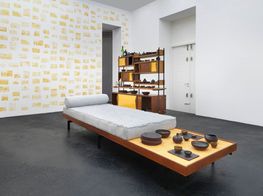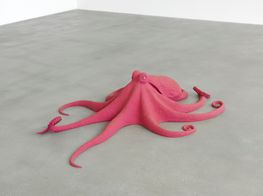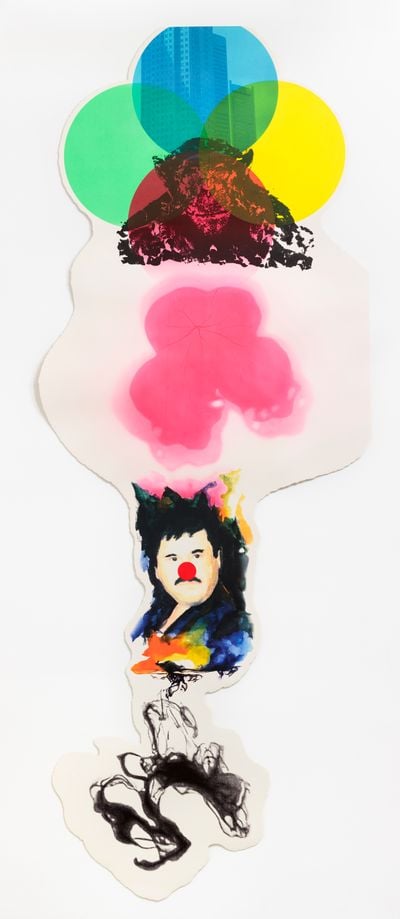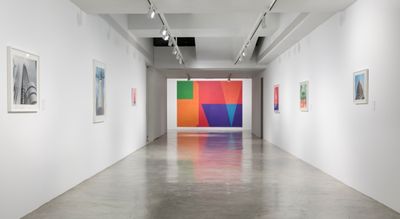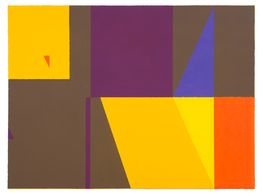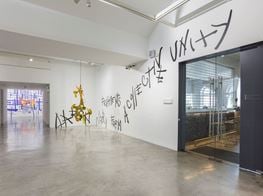Rirkrit Tiravanija and Tobias Rehberger at STPI, Singapore
A familiar childhood activity to many, the game of 'exquisite corpse' was invented by the Surrealists as a means of assembling disparate images—usually of bodies—to create an unusual and often humorous result. To play, one player draws part of an image, then folds the paper so as to hide their work and reveal only a hint of what the next participant must use to continue the drawing. The discordant combination of variant imagery mimics the nature of dreams and the unconscious, pertinent areas of interest for the game's creators. The name derives from a phrase developed by Surrealists when the activity entailed stringing together words rather than images: 'the exquisite corpse shall drink the new wine'. The exhibition Exquisite Trust (Blindly Collective Collaborations) (18 March–22 April 2017) at STPI in Singapore presented the results of four well-known international artists indulging in the game: Carsten Höller, Tobias Rehberger, Anri Sala and Rirkrit Tiravanija jointly produced a body of work over the past year by utilising the materials and resources available in the extraordinarily equipped printmaking workshop at STPI. Ocula spoke with Rehberger and Tiravanija on the occasion of the exhibition.
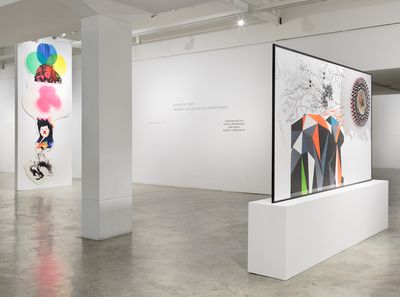
Installation view: Carsten Höller, Tobias Rehberger, Anri Sala and Rirkrit Tiravanija, Exquisite Trust (Blindly Collective Collaborations), STPI – Creative Workshop & Gallery, Singapore (18 March–22 April 2017). © the artists and STPI.
Can you tell me about your experiences experimenting with printmaking in the workshop at STPI?
RT: It was fun!
TB: [Laughs] It was fun. What's different there is that they can do lot of things that a lot of other people can't do. I did things that there I couldn't have done without having that opportunity.
Have you ever worked extensively with printmaking before?
RT: No, not me.
TB: Extensively, no. Every now and then, maybe. Every six years or something.
RT: Maybe two or three years ago, I did my first print then.
You both engage with architectural processes in your respective practices; how did an affinity for construction play in to this project?
RT: It was interesting because we both could frame our work, and I think framing in two dimensions shares similar concerns with architecture. Tobias talked a lot about this idea of framing. That part is interesting to me; finding different ways of putting something in space.
TR: Even if it's a drawing, I'm always more interested in the aspect of it being an object. For me, this project was not just about ink on paper, it was about an object with different dimensions that you can turn upside down, front to back ... So in that sense, I don't know if it was an architectural interest more than I was interested in the object.
Can there be a political significance to the practice of making exquisite corpses, in terms of bringing together bodies or the relinquishing of a dominant narrative?
RT: We talk a lot about this idea of working together which also entails losing control. For me, printmaking is a bit out of my control anyway because it's not something I think about doing all the time. But in terms of knowing or not knowing what's going to happen, Tobias has talked about giving up control but still having to remain responsible.
Tobias, what's the role of spontaneity in your own practice?
TB: I've never asked myself. I think it's more about other people's spontaneity than my own. Most of my work I really think a long time about, sometimes ten years, and so it's not very spontaneous. But I'm interested in exactly what we talked about: losing control and other people having a different perspective on my work than myself.
The Surrealists used to make exquisite corpse drawings as parlour games to pass the time. What do you both do as artists to pass the time?
RT: [Laughs] We eat a lot.
TB: We eat a lot and talk a lot and take a lot of time to make an artwork.
RT: Part of why we were interested in doing this project together was to have time together. It can be playing ping pong and then inventing a new game while playing, because you know, just playing it regularly is just too regular. So there's a kind of creative process in being together that I think feeds each of us differently in terms of what we do. We also like to go to eat, because we like to talk about how that works; we're interested in how things taste or what they do to your tongue. I think in a way it's kind of coming back to how we think of what we do.
TB: It's a way to not be too direct. We talk about work while not actually talking about work.
RT: Yes, we never actually talk directly about work.
TB: Rarely. But in the end, we actually always talk about work.
What was the process of making the exquisite corpses like? Was it secretive? Did one person work on it then the work was hidden?
TB: Eitaro [Ogawa], the print master, had a lot of work to do to cover everything up. Especially, as Rirkrit said, one of the reasons why we did this project was our great idea to hang out together. However, Eitaro ended up trying to avoid having us at the workshop together, because it was difficult for him to keep to the rules of the game. We always had one or two centimeters of what the person before us had done, which really didn't convey much. That was something also that made the game unspontaneous, because it was difficult to think about how to continue. In the classic sense an exquisite corpse goes, 'head, body, legs, feet', and here maybe you got a stripe which was like, 'black, white, black, white', and that's it.
Did you ever try to mess with each other by giving a difficult stripe at the bottom?
RT: I mean, in a sense they were all difficult because it's an unconventional way of working. With exquisite corpses, you're usually shown a little line from the drawing above. In this case, it was a colour or a pattern. We didn't know what was inside or what was outside, in a way. It was difficult, but then again, why do you need to be bothered? When you do those things, you just do it.
Whose idea was it to decide these boundaries and play this game?
RT: Carsten [Höller] came up with the idea of doing exquisite corpses. But of course, the structure of printing entails testing, experimenting and a lot of planning. We couldn't be too spontaneous; we had to follow certain demands from the workshop because they had to test things to make sure they worked. There were limitations on the size or type of paper. So on top of our own rules, there was also a set of external rules that we had to be aware of. But we pushed the limits of the rules in terms of the figure and the body and the structure of how things normally proceed. And I think if we were to continue, we'd probably blow it up even more, or we would start to redefine the rules to make it maybe a little more difficult.
How could you make it more difficult?
RT: Well, we could receive a piece without knowing which stage it was at. When we worked, we knew if we were continuing the second or third part, and so we were already a little bit aware of context. Whether you're doing a figure or not, you still somehow have that frame. It would be interesting to not have a frame at all and just get a strip and go from that without any direction.
It seems there's a natural impulse to break the rules of a game which has very strict rules?
TB: It's all about breaking the rules: even if you do it with your kids, if they don't do something that breaks the rules, it's not going to be funny. You know, you always make bigger feet than you should or instead of, the normal body, you make a turtle. If you don't break the rules, it's no fun.
Did you play this game when you were kids?
TB: Sure, I think everybody did.
RT: We didn't have that in Thailand [laughs].
TR: No?
RT: No, we were playing with marbles.

